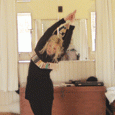Entering a new year is an important opportunity to review and renew how we might become more effective in the art of musical performance. I would like to focus on the most challenging kind of performing – that of a soloist, either on what we fondly refer to as a ‘one and done’ solo, or an entire solo concert. A New Year’s review begins with an honest self-examination as to what may be adversely affecting performances. Ask yourself whether you felt truly prepared in learning the music, not just technically but internally and musically. How did your body affect the performance? Was your mind a help or a distraction? These are the three most important aspects of training for effective performance: learning the music technically and internally; training the body; and training the mind.
Anxiety
The body can affect performance adversely most commonly through performance anxiety. We can all be sure to count on some level of physical and emotional anxiety at the moment we walk onto the stage. How we train can make the difference in learning to embrace and minimize its adverse affects. It is helpful to de-mystify anxiety by first examining the physiological responses that it creates.
Adrenaline (or epinephrine) is a hormone produced in high-stress situations. The purpose of adrenaline is to save one’s life by creating a fight-or-flight rapid response. It manifests as increased heart-rate and a generally heightened body response, so one’s life may be saved. The side effects of this response can become liabilities in performance, such as excessive perspiration, particularly in the hands, shortness of breath, dry mouth, quivering muscles, and butterflies in the stomach. When I feel this adrenaline before a performance, I have learned to view it (mind training) as extra inspiration – excitement and delighted anticipation for what is to come.
When adrenaline courses through the body, heart-rate increases and this causes breathing to become more rapid, and oxygen to be in short supply. This is a condition all wind musicians can train to alleviate. It is important to realize that the brain reacts to this physiological lack of oxygen and panics, which can be distracting. Familiarity with both the condition and the feeling itself will help musicians avoid panic mode. We also can teach ourselves to slow the heart rate, calm down, and come back to our center.
Body Training
Three methods work for me in alleviating the problems caused by a rapid heart rate and shortness of breath when in the performance spotlight. The first is daily physical training for increased endurance and lung capacity. Take the perspective of flutist as athlete. Increasing the supply of oxygen will only come from aerobic training, a genuine puff and sweat activity, much like the work of any athlete. It means a consistent practice of aerobic activity, with emphasis on consistent. I walk aerobically five days a week on the treadmill for thirty minutes (or forty-five, on an ambitious day). Alternatively, I ride fiercely on my bike outdoors for at least an hour, or walk in the woods at an aerobic pace for two or more hours. I have also practiced Yoga for over fifteen years, and though this is not particularly aerobic, it is vital to my flexibility, strength, depth of breathing, and mind focus.
Not only are these methods physically helpful to flute training, but I find in each of them a personal grounding – a place where I know myself, and work with whole-hearted attention to dig deeply, pushing beyond my own apparent limitations. Flute playing is an enormous physical challenge, particularly as one’s age increases, so keeping physically fit is essential. Here, the foundation of our being is being prepared for the rigors of performance.
My second method of physical training involves the flute. Let us console ourselves with the fact that the most challenging piece of music in your performance is your first one. This is where your heart rate will be at its highest speed, with the resulting necessity for more oxygen. I train for this by either running a flight of stairs, or doing a series of wind sprints to deliberately raise my heart-rate. Once I have done these sprints, I immediately pick up the flute in this out-of-breath condition and play the piece of music. I make it a game for myself (mind training), that no matter how extreme my puffing is, I do not stop until the first piece (or first movement) is finished. This training specifically and perfectly simulates a state you may find yourself in during a performance, with one happy exception: you will never be this out of breath in an actual performance. It trains you to the extreme, so you become familiar with both the need for oxygen and for the mind to calm the respiratory system down.
This extreme sport also teaches you to prepare for added breaths without interrupting the musical lines, since now extra breaths will not be an urgent gasp in performance, but planned for ahead of time due to this training method. You learn not to let the brain fool you with declarations of, “I’m dying, here, no oxygen; too much oxygen! Someone stop this train!” You instead become intimately acquainted with what is, after all, only a feeling of panic, not an actual emergency. It is a wonderful training method that incorporates both body and mind.
My final physical method comes into play minutes before walking out onto the stage to perform. Without playing, I put myself through a series of deep inhalations through the nose, full abdomen expansion, hold it, and then proceed with a deep but very controlled exhalation through the mouth, continuing until there is not a single drop of air remaining. I may even form a flute embouchure using one of my fingers for the flute if I want to control the exhale more keenly and slowly. This allows my body to receive ample oxygen, while placing my system where I need it for optimal playing. It feels as if I have already played a first piece before I walk out onto the stage with this breathing exercise.
Music Training
Another vital and undeniable element to improving your performance is being absolutely prepared, technically. This means you really know the music and are in a peaceful place toward it, a kind of “I completely understand this piece, and can’t wait to perform it,” repose. The way you approach daily practicing will have much to do with whether you can play calmly in the storm. I spend much of my practice time with a prevalent awareness on relaxing muscles in my hands, face, throat, and shoulders, particularly during the difficult passages, while never sacrificing the musical energy or intensity. Just because what you are doing is difficult does not mean it should look like a painful struggle. An unfurrowed brow, confident and inviting posture, joy in what you physically communicate in your delivery – there is only one thing that will get you to this kind of performance repose, and that is careful preparation over time.
Visualization Mind Training

Another way to prepare is through visualization. See yourself happily performing while you prepare the notes and phrases and the story you will tell. This is also a good technique to use before falling asleep at night, or while on an airplane, in a car, or any place you are already in a state of relaxation. Picture yourself on the stage in utter joy and offering your best self. Rehearse serene experiences and feelings that are manifested by them. Think about how you feel when great news comes to you; the supreme beauty of a lake sunset; the sweet sound of songbirds; or the smell and sight of flowers. Engage as many senses as you can in the visualization. Everyone visualizes future events, so make sure you only visualize helpful images. The alternative is to focus on the “what if” fearful chains of thoughts. Such as, you forgot to dress for the concert, and come out in your pajamas; or you walk out and start to play but the flute is broken – don’t go here, except for a laugh. Visualize joy and fulfillment.
Both physical training and visualizations of seeing yourself utterly delighted to perform will help bring your performances to the level you want them to be. Do you love flute and music, and have you prepared? This is cause for joy – you are doing something that feeds your soul, and feeds those who listen. As a more worldly and noble vision, you are being permitted to be an Artist in what you do and offer, a timeless beauty. Don’t allow yourself to relinquish this positive vision by minimizing what you are striving for. Train deliberately for the best outcome. It is all in your physical, cerebral, and emotional practice methods.
Character Training
Finally, I add a fourth element to performance training: courage. I think of courage as character training. Courage is required to perform publically. There is no getting past this truth, as we walk out into an unknown world with fear and trepidation. Courage shows up in my own daily training. It requires courage to look at myself in front of a full-length mirror in performance mode as I practice, especially if my hair is completely disheveled or I wish for an entirely different body on this day or this year. I cannot hide from what is before me, so the only productive response is to embrace it. This is a great moment of courage because it demands that I accept myself as I am, right here, right now, and set to work to improve, to create Art.
Courage is also called for when learning anything new – a new technique, flute or piece of music. I accept that I may not yet be adept at the particular task at hand. However, I am emphatically saying yes to improvement and simultaneously agreeing to accept the necessary work and time required. I will always get better at something if I am persistent, and work for improvement deliberately and consistently. What greater life goal than this? We are simply the fortunate few who get to practice this as our way of life as performing musicians. If we can do this in our practicing and training hours, we can then expect to bring it into every performance. Flutists are practicing monks, musically speaking, if we train to approach it as the soulful work it really is.
As a final thought in improving the effectiveness of live performances, I would like to suggest that you perform as often as possible. If you only perform once a year, you will not have the opportunity to become better acquainted with the challenges involved (body, mind, and music). You set yourself up to remain fearful because stepping out into the spotlight is too rare to become familiar and friendly toward those bright lights and keen ears before you. Start by performing for family or friends, or in local churches – situations with people who will love you no matter how you play. That is the real state of your audience, by the way; they are on your side. but it takes some mind training to see them this way.
Accumulating positive performance experiences will expedite your progress in the true gift that performance offers, first to your own self, and then to your listeners. The only thing to fear is poor training and unpreparedness, so take up courage and attend to your daily training. Make a New Year’s resolution today to begin specific methods to evolve confident performance prowess and effectiveness, so your music will soar without human obstruction into the hearts of your listeners.






